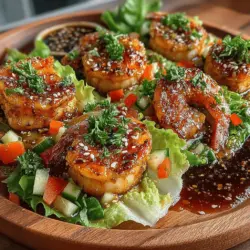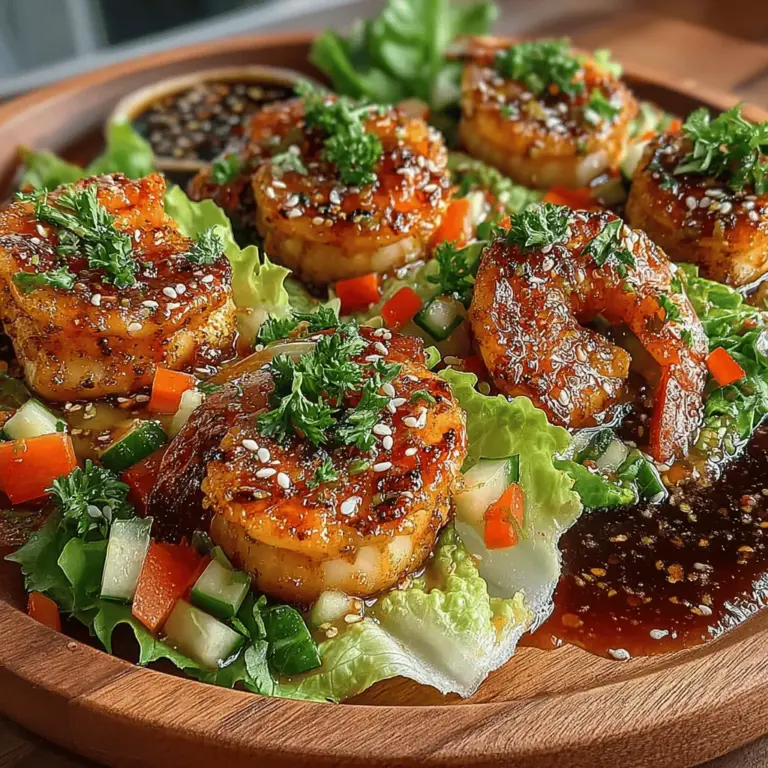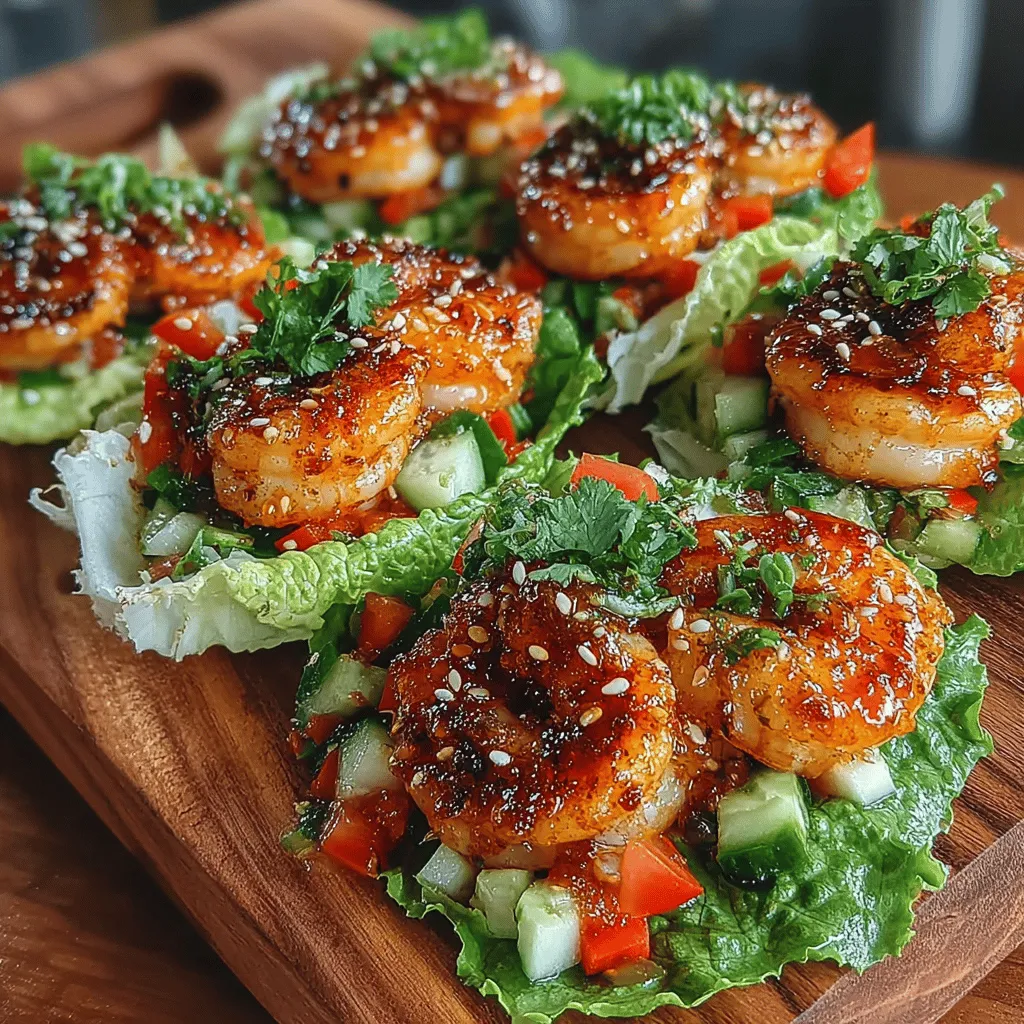Introduction
Delight in the fresh and vibrant flavors of Shrimp Lettuce Wraps with Watermelon Glaze, a perfect dish for warm weather or entertaining guests. This recipe combines succulent shrimp marinated in aromatic ingredients with a sweet and tangy watermelon glaze, all wrapped in crisp lettuce. Whether you’re looking for a light meal or a stunning appetizer, these wraps are sure to impress. In this article, we’ll explore the ingredients, preparation steps, and the exciting flavors that make this dish a must-try.
Understanding the Ingredients
Exploring Fresh Ingredients for Flavorful Wraps
The success of Shrimp Lettuce Wraps with Watermelon Glaze lies in the quality and freshness of its ingredients. Each component plays a vital role in creating a dish that is not only delicious but also visually appealing.
The Role of Large Shrimp in the Dish
When it comes to shrimp, opting for large shrimp is essential. Their size not only makes them easier to handle but also allows them to absorb the marinade more effectively, resulting in a more flavorful bite. Large shrimp provide a satisfying texture and a meaty quality that complements the crispness of the lettuce wraps. For the best results, choose shrimp that are fresh or properly thawed if previously frozen. Look for shrimp that are firm to the touch and have a mild ocean scent.
Importance of Fresh Produce
Fresh produce is central to the flavor profile of this dish. Watermelon serves as the base for the glaze, contributing a natural sweetness that balances the savory elements. Selecting a ripe, juicy watermelon is crucial; it should be firm with a uniform shape and a deep color, signaling ripeness.
In addition to watermelon, other fresh ingredients like bell pepper, cucumber, and scallions add crunch and a burst of flavor. Bell peppers introduce a subtle sweetness and vibrant color, while cucumbers provide refreshing notes and a satisfying crunch. Scallions add a mild onion flavor that enhances the wraps without overpowering them.
The Significance of Aromatics
Aromatics like garlic, ginger, and herbs are essential for building layers of flavor in these wraps. Garlic adds depth, while ginger brings warmth and a slight spiciness that enhances the shrimp. Fresh herbs, such as cilantro or mint, can elevate the dish further, adding a fragrant touch that brightens the overall flavor profile.
Breaking Down the Watermelon Glaze
The watermelon glaze is the star of this dish, providing a sweet and tangy complement to the shrimp.
Using Fresh Watermelon for Natural Sweetness
Using fresh watermelon in the glaze not only infuses natural sweetness but also contributes to the dish’s vibrant color and refreshing taste. The juicy nature of watermelon allows for a luscious glaze that clings beautifully to the shrimp and vegetables.
The Balance of Flavors
To achieve the perfect balance of flavors in the glaze, honey or maple syrup can be added for extra sweetness, while rice vinegar introduces a tangy kick that cuts through the richness of the shrimp. This combination creates a harmonious blend that tantalizes the palate and enhances the overall experience of the wraps.
Thickening Agents: Cornstarch
To ensure the glaze has the right consistency, cornstarch is used as a thickening agent. This step is crucial, as it helps the glaze adhere to the shrimp and vegetables without becoming too watery. The cornstarch is mixed with water to create a slurry, which is then added to the watermelon mixture as it cooks, resulting in a glossy finish that enhances the presentation of the dish.
Preparation Steps for Shrimp Lettuce Wraps
Crafting the Watermelon Glaze
The first step in creating these delightful wraps is to prepare the watermelon glaze, which requires a few key steps to ensure maximum flavor and the ideal consistency.
Detailed Steps for Pureeing and Straining Watermelon
Begin by cutting a ripe watermelon into cubes, removing the rind and seeds. Place the watermelon chunks into a blender or food processor and puree until smooth. For an ultra-smooth glaze, strain the puree through a fine mesh sieve or cheesecloth to remove any pulp, resulting in a silky liquid that will form the base of the glaze.
Cooking Techniques to Enhance the Glaze’s Flavor
Once the watermelon juice has been strained, transfer it to a saucepan over medium heat. Add honey or maple syrup and rice vinegar, stirring to combine. Allow the mixture to simmer, which helps to concentrate the flavors and reduce the liquid slightly. This cooking process not only enhances the glaze’s sweetness but also allows the acidity from the vinegar to meld beautifully with the watermelon.
Tips for Achieving the Right Consistency with Cornstarch
As the glaze simmers, it’s time to prepare the cornstarch slurry. Mix equal parts cornstarch and cold water in a small bowl until smooth. Gradually add this mixture to the simmering glaze while stirring continuously. Keep cooking until the glaze thickens, which usually takes just a couple of minutes. The final result should be a glossy, thickened sauce that clings perfectly to the shrimp and vegetables, ready to elevate your lettuce wraps.
Marinating the Shrimp
Once the glaze is prepared, it’s time to marinate the shrimp, a crucial step in developing robust flavors.
The Impact of Marination on Flavor Development
Marinating the shrimp allows the aromatic ingredients to infuse their flavors deeply into the seafood. This step is essential for achieving a dish that is not only appetizing but also satisfying. The marinade should ideally include garlic, ginger, a splash of soy sauce, and a touch of sesame oil, which together create a savory mixture that enhances the shrimp’s inherent sweetness.
How Long to Marinate for Optimal Results
For optimal flavor, marinate the shrimp for at least 30 minutes, allowing enough time for the flavors to penetrate. However, if time permits, marinating for up to two hours will yield even better results. Be cautious not to marinate for too long, as the acid in the marinade can begin to cook the shrimp, affecting their texture.
Alternative Marination Options for Different Dietary Needs
For those with dietary restrictions or preferences, there are numerous alternatives to consider. For a gluten-free option, use tamari instead of soy sauce. Vegetarians or those looking to reduce seafood consumption can substitute shrimp with firm tofu or tempeh, which can absorb the marinade just as well and provide a satisfying texture.
Cooking the Shrimp to Perfection
The final step before assembling the wraps is to cook the marinated shrimp, ensuring they are flavorful and tender.
Best Practices for Stir-Frying Shrimp
To cook the shrimp, heat a tablespoon of oil in a large skillet or wok over medium-high heat. Ensure the pan is hot before adding the marinated shrimp, as this will help achieve a beautiful sear. Cook the shrimp for about 2-3 minutes on each side, or until they are opaque and just cooked through. Be careful not to overcrowd the pan, as this can lead to steaming rather than frying, resulting in a less desirable texture.
Following these preparation steps will set the stage for assembling your Shrimp Lettuce Wraps with Watermelon Glaze, allowing you to create a dish that is not only impressive in presentation but also in flavor. As you dive into the vibrant colors and fresh ingredients, you’ll find that these wraps are perfect for any occasion—whether it’s a casual weeknight dinner or an elegant gathering with friends.
Identifying When Shrimp is Properly Cooked
Cooking shrimp to perfection is key to achieving the best flavor and texture in your shrimp lettuce wraps. Properly cooked shrimp is opaque and has a firm texture. Here are some tips to help you recognize when your shrimp is ready:
1. Color Change: Raw shrimp are gray and translucent. As they cook, they turn pink and opaque. This transformation is a clear indication that your shrimp is cooking correctly.
2. Curling: When shrimp are cooked, they tend to curl into a C-shape. If they are tightly curled into an O shape, they may be overcooked. Aim for a gentle curl that indicates they are just right.
3. Cooking Time: Generally, shrimp cook quickly—about 2-3 minutes per side over medium heat. Keep an eye on them to prevent overcooking, as they can become rubbery if left too long.
If you prefer to experiment with various cooking methods, here are some alternatives:
Suggestions for Alternative Cooking Methods
– Grilling: Grilling shrimp adds a smoky flavor that pairs wonderfully with the sweetness of the watermelon glaze. Preheat your grill to medium-high heat and thread shrimp onto skewers for easy flipping. Grill for 2-3 minutes per side, until cooked through.
– Baking: Baking shrimp is an excellent method for those who want a hands-off approach. Preheat your oven to 425°F (220°C), place shrimp on a baking sheet, drizzle with olive oil, and season as desired. Bake for 8-10 minutes or until they turn pink and opaque.
Assembling the Lettuce Wraps
Choosing the Right Lettuce
The type of lettuce you choose can significantly impact the texture and flavor of your shrimp lettuce wraps. Here’s a breakdown of two popular options:
– Butter Lettuce: This variety has soft, pliable leaves that are perfect for wrapping. Its mild, slightly sweet flavor complements the shrimp and watermelon glaze beautifully. Additionally, the leaves are easy to work with, making them ideal for filling with shrimp and vegetables.
– Iceberg Lettuce: Known for its crispness and crunch, iceberg lettuce provides a refreshing bite. However, the leaves are less flexible than butter lettuce, making them a bit trickier to wrap. If you prefer a crunchier texture, iceberg could be your go-to.
Tips for Preparing Lettuce Leaves for Filling
1. Choose Fresh Leaves: Look for vibrant, crisp leaves without any browning or wilting. Freshness is key to enhancing the overall experience of your wraps.
2. Rinse and Dry: Gently rinse your lettuce leaves under cold water to remove any dirt. Use a salad spinner or pat them dry with a clean towel to ensure they are not soggy.
3. Cut and Separate: Carefully separate the leaves from the stem. Keep them whole for wrapping, and trim any thick ribs to make folding easier.
Layering Flavor in Each Wrap
Building the perfect shrimp lettuce wrap is all about layering flavors. Here’s how to do it effectively:
1. Start with the Shrimp: Place a generous portion of cooked shrimp in the center of each lettuce leaf. Make sure they are well-drained to avoid soggy wraps.
2. Add Vegetables: Choose your favorite vegetables such as shredded carrots, diced cucumbers, or sliced bell peppers. These add crunch and color, enhancing both the visual appeal and the flavor profile.
3. Utilize the Watermelon Glaze: Drizzle a spoonful of watermelon glaze over the shrimp and vegetables. This sweet and tangy sauce ties the flavors together and adds a juicy element to each bite.
4. Garnishes: Finish off your wraps with a sprinkle of sesame seeds and a few cilantro leaves. The sesame seeds provide a nutty flavor and a delightful crunch, while cilantro adds a fresh herbal note.
Serving Suggestions and Pairing Ideas
Complementing Your Lettuce Wraps
To elevate your shrimp lettuce wraps experience, consider these serving suggestions:
– Suggested Side Dishes: Pair your wraps with light and refreshing sides like a cucumber salad, quinoa tabbouleh, or a simple mango salsa. These dishes will complement the flavors of your wraps without overpowering them.
– Exploring Beverage Pairings: For a drink that enhances the dining experience, consider a crisp white wine like Sauvignon Blanc or a light, fruity cocktail made with gin and tonic. Sparkling water with a splash of lime also makes for a refreshing non-alcoholic option.
– Presentation Tips: Make your dish visually appealing by serving the wraps on a large platter, garnished with additional watermelon slices and fresh herbs. Arrange the wraps in a circular fashion or stack them up for a fun and inviting display.
Nutritional Benefits of Shrimp Lettuce Wraps
Highlighting the Health Aspects
Shrimp lettuce wraps are not only delicious but also packed with nutritional benefits:
– Nutritional Profile of Shrimp: Shrimp is a great source of high-quality protein, making it an excellent choice for those looking to maintain or build muscle. Additionally, shrimp contains omega-3 fatty acids, which are essential for heart health and reducing inflammation.
– Benefits of Fresh Vegetables: The fresh vegetables added to your wraps contribute essential vitamins, minerals, and fiber. This combination enhances the nutritional value of the dish while providing a satisfying crunch.
– Low-Calorie and Low-Carb Attributes: Shrimp lettuce wraps are a fantastic low-calorie option, making them ideal for those watching their weight. The use of lettuce instead of tortillas or bread significantly reduces the carbohydrate content, making this dish perfect for low-carb diets.
Conclusion
Shrimp Lettuce Wraps with Watermelon Glaze offer a delightful combination of flavors and textures, making them a versatile dish for any occasion. With fresh ingredients and a simple preparation process, these wraps are not only delicious but also a healthy option. Whether served as an appetizer or a light meal, they are sure to be a hit with family and friends. Enjoy the refreshing taste of summer with every bite!
By incorporating these tips and suggestions, you’ll be well on your way to mastering shrimp lettuce wraps that are not only visually appealing but also bursting with flavor. So gather your ingredients, get cooking, and indulge in this unique and satisfying dish today!



